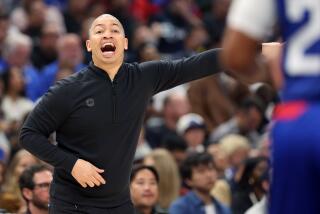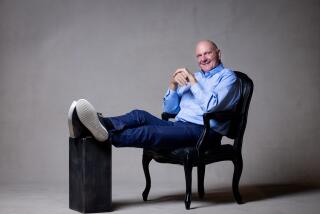Sterling Moves to Own Music
- Share via
He flirted with Anaheim. He flirted with Inglewood. But his heart always stayed in Los Angeles.
And so after three years of negotiations, after considering one proposal to move to the Arrowhead Pond and another to relocate in a new arena next to Hollywood Park, after listening to one suggestion that he move to the Forum and another that he go to Chavez Ravine, Clipper owner Donald Sterling wound up moving just a few exits down the Harbor Freeway, from the Sports Arena to the new Staples Center, which is expected to be completed in the fall of 1999.
“This was the end point from the very beginning,” said Clipper vice president of communications Joe Safety. “This was the strategy all along, to be in metropolitan L.A.”
It was not the strategy of the Ogden Corp., an arena management company that was trying to lure the Clippers to Orange County. Nor was it the strategy of an investmentgroup headed by R.D. Hubbard and Harry Ornest of Hollywood Park, who had offered to build Sterling a $150 million-$160 million arena on Hollywood Park property.
Under the terms of the Hollywood Park deal, Sterling would have retained ownership of his team, but would have handed over its management to the Hubbard-Ornest group. For giving up his control, Sterling would have received $4.5 million a year for 10 years and $5 million a year for each of the ensuing 10 years for a total of $95 million.
There were other possibilities out there. Sterling knew that Jerry Buss, owner of the Forum as well as the Lakers, would have liked to have the Clippers in his building to make up for the 41 dates he was losing by going to the Staples Center.
And Sterling was told by the Fox Group six months ago, while Fox was negotiating to buy the Dodgers, that Fox might be interested in building a basketball arena alongside Dodger Stadium.
Would Sterling be interested in playing there?
He never had to make that decision. He never heard any more from the Fox Group.
“We’ve been negotiating with the Clippers for the last three years in good faith,” said Tim Ryan of Ogden, who also serves as general manager of the Pond. “It was always our desire to see the Clippers move here on a full-time basis and there were a number of concessions we were willing to make. But there were a number of external forces that we weren’t able to deliver.”
The main force being the fact that Los Angeles is home to Sterling, has been since he moved here from Chicago as a kid, and he wasn’t willing to leave.
From the time he bought the then-San Diego Clippers in 1981, Sterling dreamed of emulating Jerry Buss by carving out his own niche as an L.A. owner.
Sterling pulled off the move up the San Diego Freeway in 1984 to relocate in his hometown.
OK, so he didn’t have the Forum and he didn’t have Jack Nicholson. But he had the Sports Arena and he had Billy Crystal and that wasn’t bad.
If only his team wasn’t so bad.
“I accepted a long time ago he wasn’t coming down here,” Anaheim Sports president Tony Tavares said.
“Obviously what they did get [from the Staples deal] coupled with the fact the arena is in the location that is suitable to the Clippers means what we could give them wasn’t enough,” Ryan said. “It has always been told to us that he [Sterling] has the desire to remain in L.A.”
Despite that fact, the Hubbard-Ornest group began to negotiate with Sterling two years ago.
“We worked hard to have the deal,” said Ornest, who has owned the St. Louis Blues of the NHL, the Toronto Argonauts of the Canadian Football League and a triple-A baseball team in Vancouver. “We both negotiated in good faith, but somehow, we could never finalize the deal.”
The reason it was never finalized was because the Staples deal heated up. The negotiations broke down several weeks ago, according to Tim Leiweke, executive vice president of the new arena. The reason given was an inability to resolve a conflict in playing dates between the Clippers, Lakers and Kings.
But actually, Sterling was unhappy over his proposed share of luxury-box revenue. Still, he figured he had another card to play.
The Clippers’ cable broadcast rights are held by the Fox Group for the next three years. Sterling was being wooed by the Disney company to join their new ESPN regional channel at the end of those three years.
So Sterling found himself in a perfect position, caught in a tug-of-war between two media giants. And one of those giants, Fox, was about to purchase 40% of the new arena.
Talk about leverage.
Sterling made it very plain that he wanted a bigger piece of the luxury-box pie.
Sources say he got it, but was the price an agreement to stick with Fox when his current cable contract ends?
Clipper executive vice president Andy Roeser denied that any agreement has been made, but don’t look for the Clippers on ESPN in the foreseeable future.
“My friend Donald Sterling blew the most unique, blockbuster arena deal in sports history,” Ornest said, “by passing on the opportunity to be the No. 1 tenant in an arena at Hollywood Park.”
Sterling, of course, doesn’t see it that way. At least it it can be assumed he feels that way. He was out of town Friday and missed the news conference to announce his team’s move.
But the important thing for Sterling is that he will be in town for a long time.
“We expect to be in this building forever,” Roeser said.
Which was Sterling’s idea from the beginning.
Staff Writers Helene Elliott and Bill Shaikin contributed to this story.
More to Read
Get our high school sports newsletter
Prep Rally is devoted to the SoCal high school sports experience, bringing you scores, stories and a behind-the-scenes look at what makes prep sports so popular.
You may occasionally receive promotional content from the Los Angeles Times.






